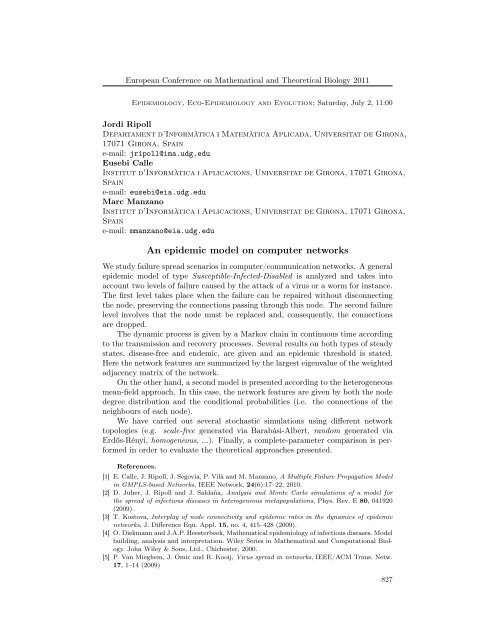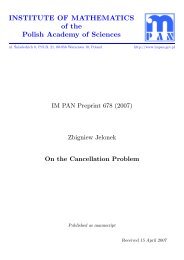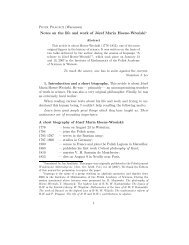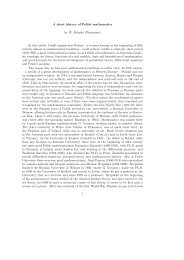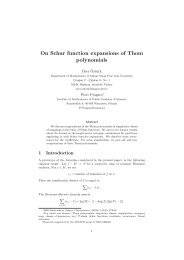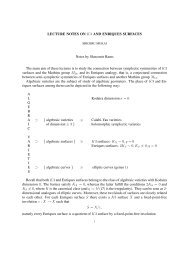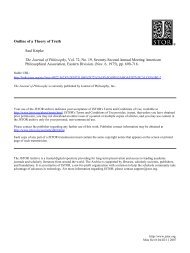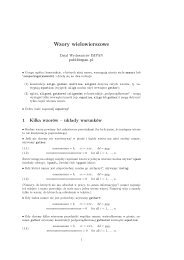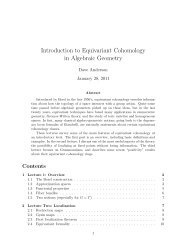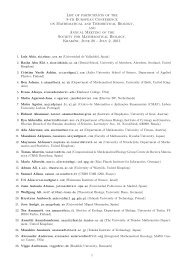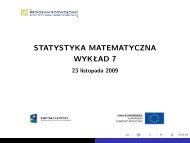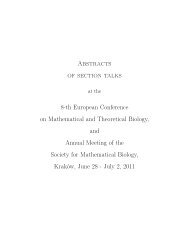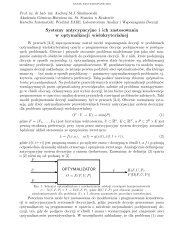Abstracts of Posters 8-th European Conference on Mathematical ...
Abstracts of Posters 8-th European Conference on Mathematical ...
Abstracts of Posters 8-th European Conference on Mathematical ...
Create successful ePaper yourself
Turn your PDF publications into a flip-book with our unique Google optimized e-Paper software.
<str<strong>on</strong>g>European</str<strong>on</strong>g> <str<strong>on</strong>g>C<strong>on</strong>ference</str<strong>on</strong>g> <strong>on</strong> Ma<str<strong>on</strong>g>th</str<strong>on</strong>g>ematical and Theoretical Biology 2011<br />
Epidemiology, Eco-Epidemiology and Evoluti<strong>on</strong>; Saturday, July 2, 11:00<br />
Jordi Ripoll<br />
Departament d’Informàtica i Matemàtica Aplicada, Universitat de Gir<strong>on</strong>a,<br />
17071 Gir<strong>on</strong>a, Spain<br />
e-mail: jripoll@ima.udg.edu<br />
Eusebi Calle<br />
Institut d’Informàtica i Aplicaci<strong>on</strong>s, Universitat de Gir<strong>on</strong>a, 17071 Gir<strong>on</strong>a,<br />
Spain<br />
e-mail: eusebi@eia.udg.edu<br />
Marc Manzano<br />
Institut d’Informàtica i Aplicaci<strong>on</strong>s, Universitat de Gir<strong>on</strong>a, 17071 Gir<strong>on</strong>a,<br />
Spain<br />
e-mail: mmanzano@eia.udg.edu<br />
An epidemic model <strong>on</strong> computer networks<br />
We study failure spread scenarios in computer/communicati<strong>on</strong> networks. A general<br />
epidemic model <str<strong>on</strong>g>of</str<strong>on</strong>g> type Susceptible-Infected-Disabled is analyzed and takes into<br />
account two levels <str<strong>on</strong>g>of</str<strong>on</strong>g> failure caused by <str<strong>on</strong>g>th</str<strong>on</strong>g>e attack <str<strong>on</strong>g>of</str<strong>on</strong>g> a virus or a worm for instance.<br />
The first level takes place when <str<strong>on</strong>g>th</str<strong>on</strong>g>e failure can be repaired wi<str<strong>on</strong>g>th</str<strong>on</strong>g>out disc<strong>on</strong>necting<br />
<str<strong>on</strong>g>th</str<strong>on</strong>g>e node, preserving <str<strong>on</strong>g>th</str<strong>on</strong>g>e c<strong>on</strong>necti<strong>on</strong>s passing <str<strong>on</strong>g>th</str<strong>on</strong>g>rough <str<strong>on</strong>g>th</str<strong>on</strong>g>is node. The sec<strong>on</strong>d failure<br />
level involves <str<strong>on</strong>g>th</str<strong>on</strong>g>at <str<strong>on</strong>g>th</str<strong>on</strong>g>e node must be replaced and, c<strong>on</strong>sequently, <str<strong>on</strong>g>th</str<strong>on</strong>g>e c<strong>on</strong>necti<strong>on</strong>s<br />
are dropped.<br />
The dynamic process is given by a Markov chain in c<strong>on</strong>tinuous time according<br />
to <str<strong>on</strong>g>th</str<strong>on</strong>g>e transmissi<strong>on</strong> and recovery processes. Several results <strong>on</strong> bo<str<strong>on</strong>g>th</str<strong>on</strong>g> types <str<strong>on</strong>g>of</str<strong>on</strong>g> steady<br />
states, disease-free and endemic, are given and an epidemic <str<strong>on</strong>g>th</str<strong>on</strong>g>reshold is stated.<br />
Here <str<strong>on</strong>g>th</str<strong>on</strong>g>e network features are summarized by <str<strong>on</strong>g>th</str<strong>on</strong>g>e largest eigenvalue <str<strong>on</strong>g>of</str<strong>on</strong>g> <str<strong>on</strong>g>th</str<strong>on</strong>g>e weighted<br />
adjacency matrix <str<strong>on</strong>g>of</str<strong>on</strong>g> <str<strong>on</strong>g>th</str<strong>on</strong>g>e network.<br />
On <str<strong>on</strong>g>th</str<strong>on</strong>g>e o<str<strong>on</strong>g>th</str<strong>on</strong>g>er hand, a sec<strong>on</strong>d model is presented according to <str<strong>on</strong>g>th</str<strong>on</strong>g>e heterogeneous<br />
mean-field approach. In <str<strong>on</strong>g>th</str<strong>on</strong>g>is case, <str<strong>on</strong>g>th</str<strong>on</strong>g>e network features are given by bo<str<strong>on</strong>g>th</str<strong>on</strong>g> <str<strong>on</strong>g>th</str<strong>on</strong>g>e node<br />
degree distributi<strong>on</strong> and <str<strong>on</strong>g>th</str<strong>on</strong>g>e c<strong>on</strong>diti<strong>on</strong>al probabilities (i.e. <str<strong>on</strong>g>th</str<strong>on</strong>g>e c<strong>on</strong>necti<strong>on</strong>s <str<strong>on</strong>g>of</str<strong>on</strong>g> <str<strong>on</strong>g>th</str<strong>on</strong>g>e<br />
neighbours <str<strong>on</strong>g>of</str<strong>on</strong>g> each node).<br />
We have carried out several stochastic simulati<strong>on</strong>s using different network<br />
topologies (e.g. scale-free generated via Barabási-Albert, random generated via<br />
Erdős-Rényi, homogeneous, ...). Finally, a complete-parameter comparis<strong>on</strong> is performed<br />
in order to evaluate <str<strong>on</strong>g>th</str<strong>on</strong>g>e <str<strong>on</strong>g>th</str<strong>on</strong>g>eoretical approaches presented.<br />
References.<br />
[1] E. Calle, J. Ripoll, J. Segovia, P. Vilà and M. Manzano, A Multiple Failure Propagati<strong>on</strong> Model<br />
in GMPLS-based Networks, IEEE Network, 24(6):17–22, 2010.<br />
[2] D. Juher, J. Ripoll and J. Saldaña, Analysis and M<strong>on</strong>te Carlo simulati<strong>on</strong>s <str<strong>on</strong>g>of</str<strong>on</strong>g> a model for<br />
<str<strong>on</strong>g>th</str<strong>on</strong>g>e spread <str<strong>on</strong>g>of</str<strong>on</strong>g> infectious diseases in heterogeneous metapopulati<strong>on</strong>s, Phys. Rev. E 80, 041920<br />
(2009).<br />
[3] T. Kostova, Interplay <str<strong>on</strong>g>of</str<strong>on</strong>g> node c<strong>on</strong>nectivity and epidemic rates in <str<strong>on</strong>g>th</str<strong>on</strong>g>e dynamics <str<strong>on</strong>g>of</str<strong>on</strong>g> epidemic<br />
networks, J. Difference Equ. Appl. 15, no. 4, 415–428 (2009).<br />
[4] O. Diekmann and J.A.P. Heesterbeek, Ma<str<strong>on</strong>g>th</str<strong>on</strong>g>ematical epidemiology <str<strong>on</strong>g>of</str<strong>on</strong>g> infectious diseases. Model<br />
building, analysis and interpretati<strong>on</strong>. Wiley Series in Ma<str<strong>on</strong>g>th</str<strong>on</strong>g>ematical and Computati<strong>on</strong>al Biology.<br />
John Wiley & S<strong>on</strong>s, Ltd., Chichester, 2000.<br />
[5] P. Van Mieghem, J. Omic and R. Kooij, Virus spread in networks, IEEE/ACM Trans. Netw.<br />
17, 1–14 (2009)<br />
827


